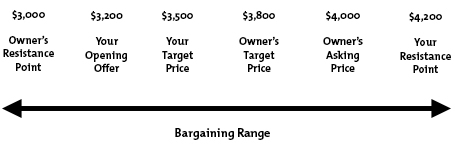Negotiating When You Can't Both Win

Understand the bargaining range.
© iStockphoto/megatronservizi
Negotiating a great price for goods and services can seem to need the tactical skills of a chess Grand Master.
For example, where do you start bidding? You don't want to pay more than you need to, but if you start too low, will the other party decide that you're a time-waster? When should you pull out if things aren't going your way? And at what point do you announce your 'best and final offer'?
"Distributive Bargaining" can help you answer all of these questions. Applied successfully, it should mean that more value is "distributed" to your side. In many situations, this is vitally important for profitability and business success.
Distributive Bargaining is all about compromise and accepting that not all negotiations can end in a win-win situation. It's used when the goods or services on offer are fixed, and you're simply negotiating on price. In fact, it's often described as a "win-lose" approach because every dollar that you reduce the price by (if you're buying) or increase it by (if you're selling) is simply a direct "win" for you and a "lose" for the other party. Having said that, both parties can still end up feeling satisfied that the final price they've agreed is a fair one.
Distributive Bargaining Basics
Distributive Bargaining assumes that, before entering a price negotiation, the participating sides will each have three critical figures in mind:
- A Target Price – this is the optimal outcome for each negotiator.
- A Resistance Point – this is the point beyond which each negotiator will not go.
- An Opening Offer (for the buyer) or Asking Price (for the seller) – this is the initial offer each side puts on the table.
Suppose you're negotiating the rent of new office space. The Asking Price is the price set by the owner of the property. Your Target Price is the price you want to pay, based on square footage. And your Resistance Point is the maximum you're willing to pay. The owner has his or her own Target Price and Resistance Point as well.
The spread between the owner's Resistance Point and your Resistance Point is the Bargaining Range. It's within this area that negotiations can actually take place, as anything outside this range will be rejected outright by one side or the other. This is shown in Figure 1 below.
Figure 1 – The Bargaining Spread

Another dynamic to be aware of is the concept of "alternatives." If either party has a viable alternative to the current deal, they can use that as leverage. In our example, if this were the only office space available and you were the only potential tenant, you'd have to reach an agreement. However, the owner knows there are other offices you could rent and you know there are other people out there looking for premises. The most favorable alternative to doing a particular deal is often known as a BATNA, which stands for Best Alternative To a Negotiated Agreement. It's worth taking some time to identify your own and the other party's BATNAs before beginning negotiations. Remember that, with Distributive Bargaining in general, the more information you can gather about the person you are negotiating with, the better.
The objective in a distributive situation is to find a settlement point you can both agree on. Each party wants to claim as big a proportion of the Bargaining Range as possible. So, although you go into the negotiation knowing you're going to give some of your position away, the critical point is that you want to give away less than the other person.
Just how much you'll be prepared to concede depends, of course, on the package on offer. In our office rental case, the money paid doesn't have to be the only bargaining point. There's a range of other options, which could be included in the deal. Maybe you're willing to pay a bit more in rent if some improvements can be made to the space before you move in. Perhaps you can get cleaning services thrown in for free. Or you might be willing to sign a longer-term lease, in exchange for lower rent. This kind of bargaining mix gives you a variety of possibilities to consider before entering the actual negotiation.
As well as this, there are some intangibles you need to consider. Questions to ask yourself include:
- What value do you place on your reputation in the bargaining situation? Will striking a hard bargain win you more respect, either from your opponent or your employer?
- Are you setting a precedent? Are you likely to have on-going or future negotiations with the same party?
- How important is it to be fair?
- Do you have certain principles you won't compromise?
- Is time a factor?
Remember to construct your own position carefully before you enter a Distributive Bargaining situation. You'll have more possibilities for negotiation, and a more comprehensive understanding of your Resistance Point.
Bargaining Strategies
Information is key to any Distributive Bargaining scenario. The more you know about the other person's motives and needs the better. So:
- Do appropriate research, and consult any relevant documents and publications in advance.
- Talk to others who've dealt with the person or company.
- Make your own direct observations and pay careful attention to any facts revealed by the other party before and during the negotiation.
Remember that in order to maximize the value of the deal for your side, you ideally want to discover the other party's Resistance Point while concealing your own. However, this is rarely easy as the other side will be equally focused on not revealing too much information!
Typically, the best you can do is influence the other party's Resistance Point so you gain more of the bargaining spread. Here are some strategies to consider:
- Create the impression that you don't need a quick settlement. If the other person recognizes that you need to close the deal without delay, they'll use that to their advantage. The more you can "wait it out," the better for you!
- Acknowledge the other party's BATNA. Make clear why your deal is more attractive to, for example, a rival bid or no deal at all. Find ways to convince the other person that delaying or ceasing negotiations with you will cost them in the long run.
- Try to undermine the other party's Resistance Point. Argue that the options you're proposing are more attractive than the one the person is holding out for. Point out things that might have been overlooked. But only reveal facts that are really necessary: play your cards close to your chest!
Positions to Take During Negotiation
You've learnt as much as you can about your opponent, and prepared your position as thoroughly as possible. Each side now takes a position. These positions are expected to change as new information is revealed, possible outcomes are debated, and the value of a likely settlement becomes clearer. Here are some factors to consider:
Opening Offer (or Asking Price, if You're the Seller)
How do you set the level of your Opening Offer? Do you want to imply cooperation by suggesting something close to your Resistance Point? Or do you begin with an extreme offer, which you can assume to be close to the other side's Resistance Point?
Doing the latter clearly gives you more room to negotiate and can often prove advantageous: it gives you more potential points at which you can settle. Perhaps more importantly though, it sends a message to the other party that you're a long way from agreement, and some major concessions will be expected. However, remember that there's always a risk in this situation that the other person will simply walk away, and, if you're hoping to have an ongoing relationship, this kind of hardball stance may prove destructive. Make sure that, if you do decide to start with an extreme offer, you've got a viable BATNA yourself to fall back on.
Your Stance
Plan what attitude you'll display during the negotiation. A tough, competitive stance will probably be met with the same. As long as you're prepared to negotiate with someone equally as stubborn, this may work for you. However, you might well prefer to take a more reasonable, cooperative approach. The other side may not reciprocate, but even the most belligerent of opponents tends to be tempered by a fellow negotiator who is calm and understanding.
Concessions
Concessions are what define Distributive Bargaining. A series of give and take offers usually leaves both sides with a sense that the negotiation was "fair" and that they've "met in the middle" somewhere. Concessions communicate that you're willing to be reasonable, and provide acknowledgement that the other party's position is legitimate. Skilled negotiators often hold back a small final concession that they can give at the end to sweeten the deal and encourage a settlement in their favor.
Final Offer
Eventually you'll get to the point where you don't want to make any more concessions. To signify that your final offer really is final, you typically put together a package of concessions that's significant enough to convince the other person there's no more room to negotiate. Saying "This is my final offer" after a single round of concessions isn't convincing. Wait until you believe you've proposed an offer that will be accepted.
Many of us can tend not to want to have to take an overly aggressive or competitive stance when we enter into negotiations. However, there are times when, to get what you want from a deal, you need the other person to make some concessions in your favor. This is when it helps to understand the basics of Distributive Bargaining.
You need to have a clear idea in your mind of your Opening Offer and Target Price, and your Resistance Point. Trying to figure out where these last two values lie for the other party will play a central role in the negotiation.
At the same time, there will be other things that could be thrown into the bargaining mix, and you need to be ready to suggest or respond to these. The greater the range of possibilities you can put forward in your opening position and subsequent concessions, the easier it should be to strike a deal that both parties can accept.
Ideally, you want to end up as close to your Target Price as possible. However, don't forget that negotiation is an interpersonal exercise, and using good judgment, understanding, and a principled approach will likely serve you best in the long run. While you want to win the lion's share of the 'distribution', don't be afraid to compromise!
Don't just treat this as theory – try it out! Next time you make a major purchase, do your homework, get past any feeling of embarrassment holding you back, and go for it. You're likely to have little to lose, and much to gain!
http://www.mindtools.com/pages/article/newCS_90.htm#np
| To Get Uninterrupted Daily Article(s) / Review(s) Updates; Kindly Subscribe To This BlogSpot:- http://ZiaullahKhan.Blogspot.com/ Via "RSS Feed" Or " Email Subscription" Or "Knowledge Center Yahoo Group". | ||
| Amazon Magazine Subscriptions | Amazon Books | Amazon Kindle Store |
| Amazon Everyday Low Prices, Sales, Deals, Bargains, Discounts, Best-Sellers, Gifts, Household Consumer Products | ||
No comments:
Post a Comment